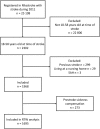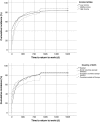Return to work after stroke: A Swedish nationwide registry-based study
- PMID: 31659744
- PMCID: PMC6916554
- DOI: 10.1111/ane.13180
Return to work after stroke: A Swedish nationwide registry-based study
Abstract
Objectives: A substantial proportion of individuals with stroke are of working age. After stroke, it is important to return to work (RTW), both for the individual's satisfaction with life and economically for society. The current comprehensive, long-term study aimed at investigating in what time period the RTW continues after stroke and what factors could predict RTW.
Materials and methods: All individuals registered in the registry Riksstroke with stroke in Sweden at ages 18-58 years during 2011 were eligible for participation. RTW was based on sickness absence data from the Social Insurance Agency covering 1 year prestroke to 5 years post-stroke. Time to RTW was analyzed with Kaplan-Meier curves. Potential predictors of RTW were analyzed with Cox regression and logistic regression.
Results: For RTW analyses, 1695 participants were included. Almost 50% RTW within 3 months, 70% within 1 year, and 80% within 2 years post-stroke. However, the RTW continued for several years, with a total of 85% RTW. Predictors of favorable time to RTW were male sex, ischemic stroke, and long university education compared with primary school education. Predictors of unfavorable times to RTW were higher stroke severity, defined by the level of consciousness, and older ages. Participants with self-expectations of RTW 1 year post-stroke had higher odds of RTW within 5 years.
Conclusions: The RTW continues for a longer time after stroke than previously known. Both self-expectations and demographical, socioeconomic, stroke-related factors were important predictors of RTW. This knowledge could assist healthcare professionals to individualize the rehabilitation post-stroke.
Keywords: follow-up study; rehabilitation; return to work; stroke.
© 2019 The Authors. Acta Neurologica Scandinavica John published by John Wiley & Sons Ltd.
Conflict of interest statement
The authors declare that they have no conflict of interests.
Figures



References
-
- Rosengren A, Giang KW, Lappas G, Jern C, Toren K, Bjorck L. Twenty‐four‐year trends in the incidence of ischemic stroke in Sweden from 1987 to 2010. Stroke. 2013;44(9):2388‐2393. - PubMed
-
- Vestling M, Tufvesson B, Iwarsson S. Indicators for return to work after stroke and the importance of work for subjective well‐being and life satisfaction. J Rehabil Med. 2003;35(3):127‐131. - PubMed
-
- Roding J, Glader EL, Malm J, Lindstrom B. Life satisfaction in younger individuals after stroke: different predisposing factors among men and women. J Rehabil Med. 2010;42(2):155‐161. - PubMed
MeSH terms
Grants and funding
LinkOut - more resources
Full Text Sources
Medical

